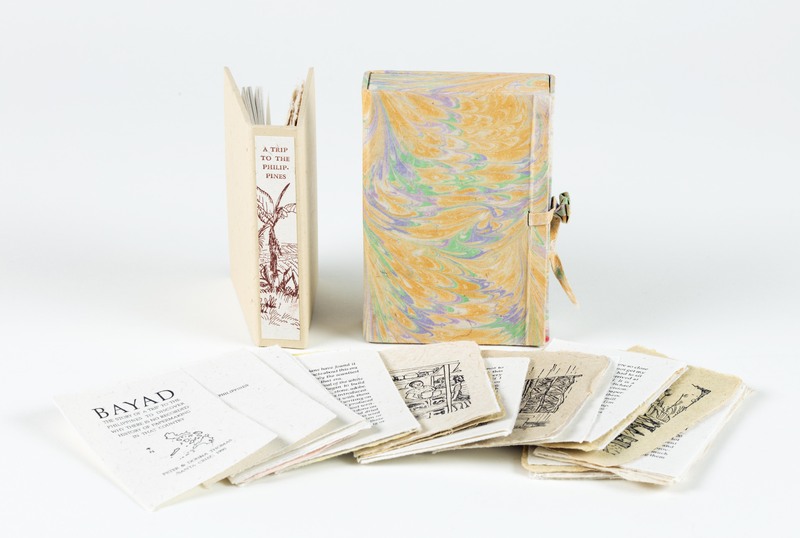A62. BAYAD - The Story of a Trip to the Philippines to Discover Why There is No History of Papermaking in That Country
A62. Peter Thomas. Bayad - The Story of a Trip to the Philippines to Discover Why There is No History of Papermaking in That Country. Santa Cruz, California: Peter & Donna Thomas, 1990.
76 x 51 mm (3” x 2”), 32 pages, 50 copies.
Binding: Copies 1-10 are housed in a Hako Chitsu box covered in handmade Philippine suminagashi paper made at the Duntog Paper Mill. Text and illustrations held by a white silk ribbon. Copies 11-50 are stab bound by Peter and Donna Thomas and housed in a case binding made with German ochre paper over boards; last page of text block is slid into a pocket at back of case. Label with title and illustration on spine. Illustrations held by white silk ribbon to front inside cover. Paper: Text printed on white with brown Philippine plant fibers, handmade by Peter Thomas. Illustrations printed on various colors and fibers, handmade in the Philippines by Nida Dumsang. Printing: Text is digital. Illustrations are letterpress. Typography: Digitally set Palatino. Illustration: Reproductions of nine line drawings by Donna Thomas.
“The text was compiled from diary entries and letters I composed on my research trip to research the history of papermaking in the Philippines. The text was photocopied onto my handmade paper. We did not print on the back side of the paper because a photo copy machine cannot produce front and back pages that are in exact registration. To best feature this one-sided page, and to honor the Philippines' Asian heritage, we decided to make a book with a stab-sewn text block. We then letterpress printed the illustrations on business-card-sized pieces of handmade paper that we had purchased from a hand paper mill in the Philippines. These cards were too stiff to use in a stab binding and we developed the idea of a case-bound portfolio as a way to integrate these two different elements into one book. The stab-sewn text was held inside the back cover by sliding the last page under a glued down paper band; the illustrations were attached inside the front cover with ribbon ties. Further exploration of this idea led to the creation of the binding that we call the ‘case-bound pocket portfolio.’ It was used again later for A Papermaking Safari to Africa [A78] and we describe how to make it in More Making Books by Hand [F1]. We were not really satisfied with the slight fuzziness of laser printed type and rarely used laser printing for books with type after that.”
